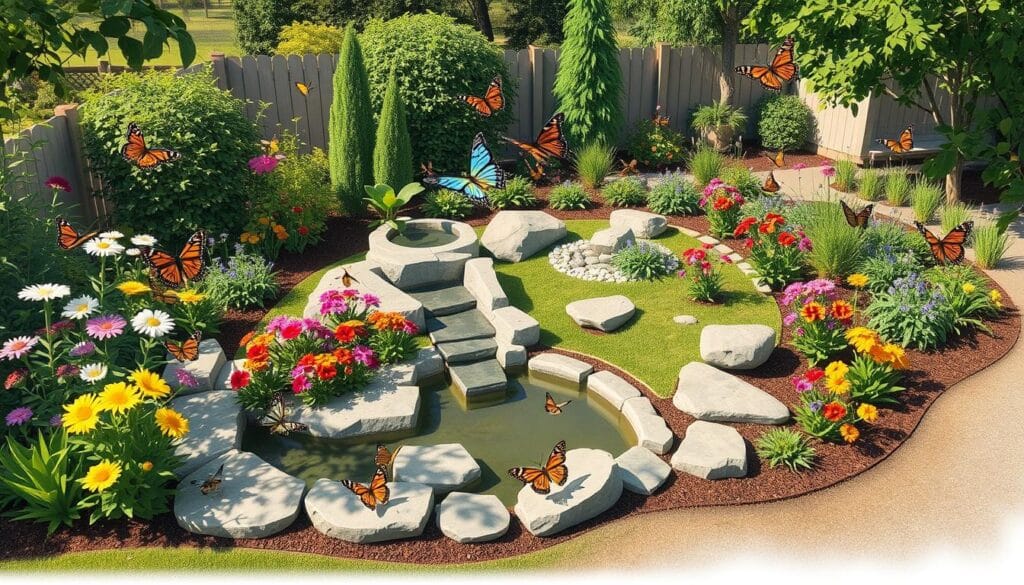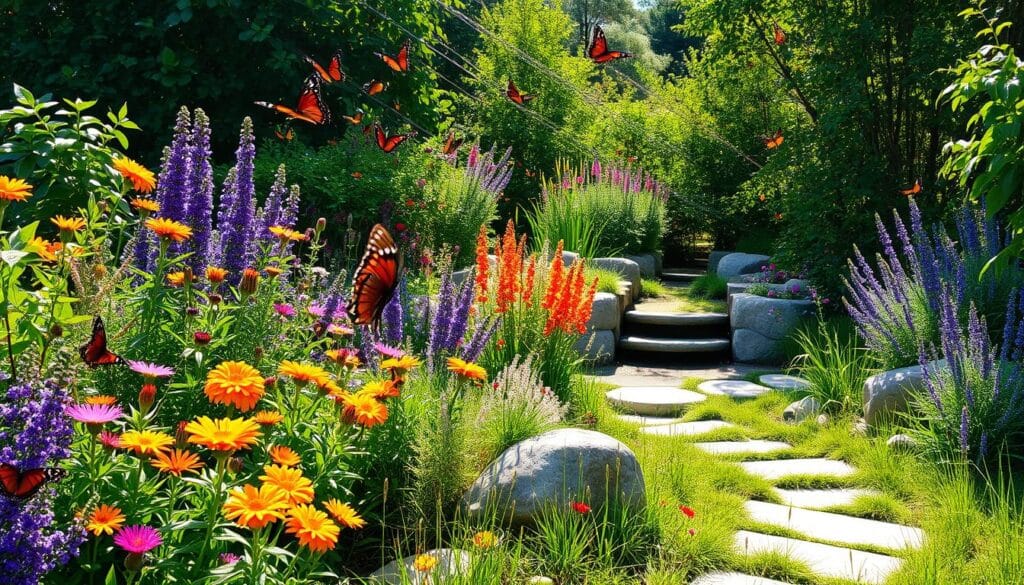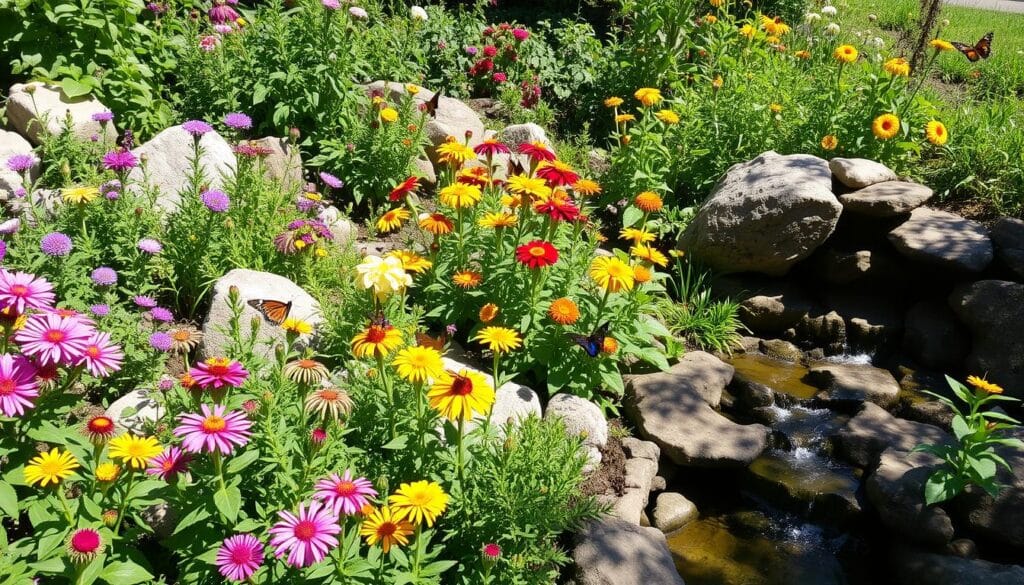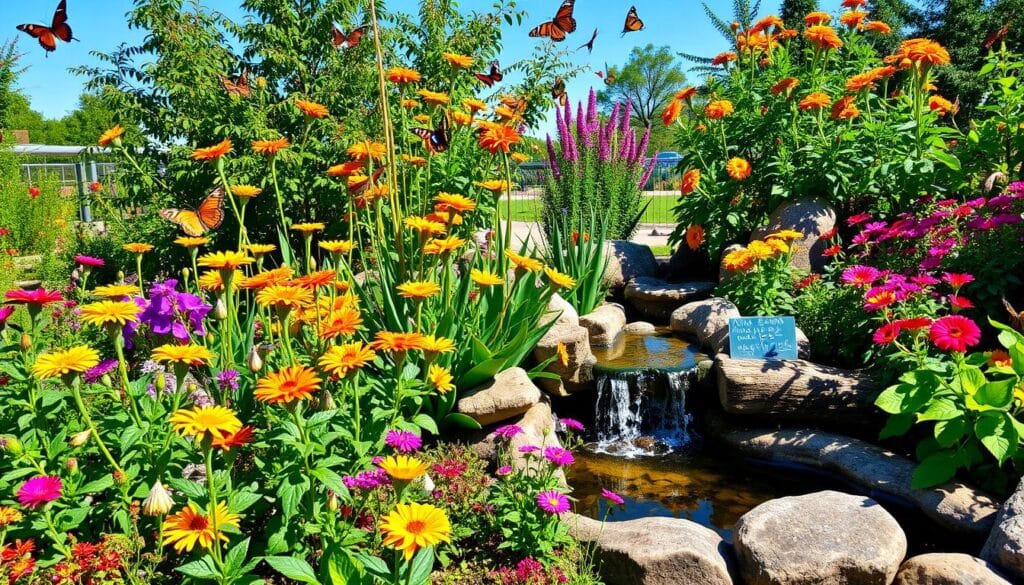Imagine stepping into your backyard and seeing vibrant colors and butterflies fluttering around. Adding butterfly-friendly plants and pollinator garden ideas can make your outdoor space a haven for wildlife. With some planning and knowledge of butterfly garden design, you can attract many butterfly species and enjoy nature’s beauty.
To create a butterfly sanctuary, focus on providing the right environment. Choose a sunny spot, add water features, and pick flowers rich in nectar. This way, you can make a haven for butterflies and other pollinators. With the right design and landscaping, you’ll enjoy a thriving ecosystem and help the local environment.
Key Takeaways
- Choose a sunny spot for your butterfly garden to attract butterflies
- Incorporate a variety of nectar-rich flowers and host plants to support the entire butterfly lifecycle
- Provide water features, such as birdbaths or small ponds, to attract butterflies
- Select plants with varying bloom times to sustain multiple butterflies and their offspring
- Avoid using pesticides in your butterfly garden, as they can be harmful to butterflies
- Consider planting flowers in clusters of the same color to attract butterflies
Understanding Butterfly Garden Design
To make a butterfly garden thrive, knowing the design basics is key. Pick the right spot and use native plants to draw butterflies. A good garden gets at least six hours of sun and has both open and sheltered areas.
Choose plants that offer nectar for adults and food for caterpillars. Native plant selection for butterflies is vital. It means the plants fit the local weather and give butterflies what they need. Plants like butterfly bush, milkweed, and fennel are great choices. They help attract butterflies to your yard and aid in their survival.
Designing a butterfly habitat is crucial. It needs flowers for nectar and host plants for caterpillars. A well-thought-out garden supports butterflies and other helpful insects.
- Provide shallow water, like saucers with wet sand
- Use windbreakers, like dense shrubs or tall grasses
- Make paths with natural materials and avoid pesticides
Follow these tips and use native plants to make a stunning butterfly garden. It will attract these amazing creatures and help protect them.
Choosing the Right Location
When setting up a butterfly garden, picking the right spot is key. You need a place that gets lots of sunlight. Butterflies need at least 6 hours of direct sunlight each day to do well. Think about your garden’s orientation and the area around it to make sure it gets enough sun.
Also, having water nearby is important for a butterfly garden. Butterflies drink water and use it to keep their body temperature right. Adding a shallow pond or a birdbath with fresh water is a great idea. Here are some butterfly garden layout tips to keep in mind:
- Choose a location that receives full sun to partial shade
- Select a spot that is close to a water source
- Consider the DIY butterfly garden design and create a layout that is easy to maintain
By following these butterfly garden layout tips and thinking about planting for butterfly conservation, you can make a beautiful butterfly garden. This garden will attract many different butterfly species. Also, think about the plants you’ll use. Some plants are better for butterfly conservation than others.

With some planning and creativity, you can make a stunning butterfly garden. This garden will be a home for these beautiful creatures and make your outdoor space more beautiful. By using DIY butterfly garden design and planting for butterfly conservation techniques, you help the local butterfly population. You’ll also enjoy a thriving ecosystem.
| Butterfly Species | Host Plant | Water Source |
|---|---|---|
| Monarch | Milkweed | Shallow pond |
| Black Swallowtail | Golden Alexander | Birdbath |
| Painted Lady | Pussytoes | Damp soil |
Selecting Native Plants
Creating a butterfly-friendly garden starts with choosing the right plants. Native plants are key because they offer food and shelter for butterflies. A well-designed garden can attract many species and be a beautiful, sustainable space.
Plants like Joe Pye weed, blue vervain, and zinnias are great for attracting butterflies. They are not only pretty but also provide nectar and host plants for caterpillars. Adding these plants to your garden helps support local wildlife.
Here are some native plants to consider:
- Joe Pye weed: attracts monarch, tiger swallowtail, and viceroy butterflies
- Blue vervain: appeals to buckeye and monarch butterflies
- Zinnias: attract monarch and swallowtail butterflies

By picking native plants and creating a butterfly-friendly garden, you help conserve these creatures. You also enjoy a sustainable and thriving ecosystem.
| Plant | Butterfly Species | Height |
|---|---|---|
| Joe Pye weed | Monarch, tiger swallowtail, viceroy | 3-12 feet |
| Blue vervain | Buckeye, monarch | 4-6 feet |
| Zinnias | Monarch, swallowtail | 1-3 feet |
Designing for Butterfly Habitats
To create a butterfly habitat, you need to think about what these creatures need. Designing a butterfly garden means adding host plants for caterpillars, shelter, and nectar sources. This setup helps attract butterflies and supports their life cycle.
When designing a butterfly garden, remember that butterflies need shelter from the wind. Bushy plants and native plants are great for this. Female butterflies look for host plants for their offspring, besides nectar plants, to find the right plants.
Creating Host Plants for Caterpillars
Host plants are where butterflies lay eggs and caterpillars eat. Different butterflies need specific host plants, like milkweed for monarchs and pawpaw for zebra swallowtails. Adding these plants to your garden makes it welcoming for butterflies to lay eggs and for caterpillars to grow.

Providing Shelter and Nectar Sources
Butterflies also need shelter and nectar sources to survive. Adult butterflies find nectar in various flowers and are less picky about nectar plants. Adding native plants, like trees and wildflowers, to your garden provides shelter. This variety supports butterflies’ needs at every stage of their life.
| Butterfly Species | Host Plant | Nectar Source |
|---|---|---|
| Monarch | Milkweed | Zinnia, Marigold |
| Zebra Swallowtail | Pawpaw | Butterfly Bush, Lantana |
Incorporating Butterfly-Friendly Features
To make your space welcoming for butterflies, add the features they need to thrive. Butterfly-friendly landscaping includes water sources like shallow birdbaths or small ponds. These provide butterflies with a place to drink and puddle. This is key in attracting butterflies to your yard.
Think about what features will draw butterflies to your garden. For example, natural decorations like rocks, logs, and native plants offer shelter and perches. Also, include flowers rich in nectar, such as milkweed, coneflowers, and zinnias. These attract butterflies and other pollinators.

- Butterfly houses or shelters provide protection from the elements
- Annual pollinator strips to attract a variety of butterfly species
- Spring bulbs like crocus and squill to support butterflies early in the season
- Late fall-blooming plants like asters provide food for butterflies
By adding these features, you can create a haven for butterflies. Choose plants native to your area. This ensures butterflies have what they need to thrive.
| Feature | Benefit |
|---|---|
| Water sources | Provide drinking water and puddling sites for butterflies |
| Natural decorations | Provide shelter and perches for butterflies |
| Nectar-rich flowers | Attract butterflies and other pollinators |
Implementing Sustainable Practices
Creating a DIY butterfly garden design means thinking about the environment. Use organic pest control and harvest rainwater to help. These steps reduce your impact and make a great home for butterflies.
To make a beautiful and green butterfly garden, try these tips:
- Choose native plants. They need less water and care and feed butterflies well.
- Use natural ways to control weeds, like hand-weeding and mulching. This cuts down on chemical use.
- Collect rainwater with a barrel or cistern. It’s great for watering your garden.
By using these tips and sustainable methods, your garden will be a hit with butterflies and the planet.
| Sustainable Practice | Benefits |
|---|---|
| Organic Pest Control | Reduces harm to local wildlife and ecosystems |
| Rainwater Harvesting | Conserves water and reduces stormwater runoff |
| Native Plant Species | Supports local biodiversity and requires less maintenance |
Planning for Seasonal Changes
Creating a butterfly habitat means thinking about the seasons and how they affect your garden. It’s key to plant for butterfly conservation to keep nectar flowing all year. By picking plants that bloom at different times, you can attract many species.
To make a butterfly habitat, choose plants that do well in your area and offer nectar. Phlox paniculata ‘Flame Pink’, Penstemon ‘Rock Candy Blue’, and Bee balm (Monarda ‘Balmy Purple’) are great choices. They’re not just pretty; they also feed butterflies.
For winter, add plants that give shelter and food to butterflies. Coreopsis ‘Solanna Golden Sphere’, Sedum ‘Brilliant’, and Shasta daisies (Leucanthemum ‘Sweet Daisy Jane’) are good options. These plants will help your garden thrive and support butterflies.
- Choose plants that bloom at different times to ensure a continuous nectar supply.
- Prepare your garden for winter by adding plants that provide shelter and food.
- Consider using native plants, which often require less water and maintenance.
By following these tips and designing a thoughtful butterfly garden, you can support local butterflies. You’ll also get to enjoy their beauty in your backyard.
| Plant | Zone | Bloom Time |
|---|---|---|
| Phlox paniculata ‘Flame Pink’ | 4-8 | Summer |
| Penstemon ‘Rock Candy Blue’ | 3-8 | Spring |
| Bee balm (Monarda ‘Balmy Purple’) | 4-8 | Summer |
Monitoring and Maintaining Your Garden
To make your butterfly garden thrive, you need to keep an eye on it and take care of it. Watch how butterflies move around, do regular upkeep, and use butterfly garden layout tips. This way, you’ll have a place where butterflies feel at home and you can enjoy their presence.
For a healthy garden, pick native plants and offer host plants for caterpillars. Use DIY butterfly garden design ideas to make your garden special. Guides on how to design a butterfly garden can also be helpful. Prune plants, change up the flowers, and add a water source to keep butterflies coming back.
Here are some tips to keep in mind:
- Choose nectar-rich plants like milkweed, coneflowers, and lantanas
- Provide host plants like parsley, dill, and wild violets
- Avoid using pesticides and opt for natural pest control methods
- Observe and adjust plant varieties based on butterfly attraction
By following these tips and using butterfly garden layout tips in your design, you can make a stunning butterfly garden. It will attract many different species. Always think about the health of your garden and its creatures.
| Plant Type | Nectar Source | Host Plant |
|---|---|---|
| Milkweed | Yes | Yes |
| Coneflowers | Yes | No |
| Lantanas | Yes | No |
Community Involvement in Butterfly Conservation
To attract butterflies to your yard, it’s key to join your community. Join local gardening groups and take part in butterfly counts. This way, you support conservation efforts and learn about native plants.
Many communities have projects to help butterflies. For instance, the Rosalynn Carter Butterfly Trail has over four thousand gardens in the United States. These gardens, from small balconies to large fields, use native plants like milkweed and marigolds.
Here are some ways to get involved:
- Look for local gardening groups and attend their meetings or events
- Join in butterfly counts and surveys to track their numbers
- Share your knowledge with others to help conserve butterflies
Together, we can build a network of butterfly habitats. Let’s start making a difference in our communities today.
| Community Initiative | Description |
|---|---|
| Rosalynn Carter Butterfly Trail | A network of over four thousand gardens promoting butterfly conservation |
| Local Gardening Groups | Meetings and events for gardeners to share knowledge and experience |
| Butterfly Counts | Surveys to track population trends and support conservation efforts |
Expanding Your Garden’s Butterfly Appeal
After setting up your butterfly garden, think about how to make it even better. Designing a
butterfly habitat for schools
can be very rewarding. It lets you teach and inspire kids about the importance of butterflies. By working with schools, you can create a place where kids can watch and learn about butterflies.
Also,
engaging neighbors in gardening projects
can make a big difference. Ask your neighbors to add butterfly-friendly plants to their yards. This creates a network of habitats for butterflies. Together, you can offer more food and shelter for different butterfly species.
Butterflies show us that our environment is healthy. They bring joy and wonder to our gardens. By making your garden more appealing to butterflies, you help protect these amazing creatures. You also help keep our ecosystem healthy for future generations.
FAQ
What are the benefits of creating a butterfly garden?
A butterfly garden is a vital food and shelter source for these creatures. By attracting them, you enjoy their beauty and help their conservation.
How do I choose the right location for my butterfly garden?
Choose a spot with lots of sunlight and near water. A sunny area with water attracts many butterfly species.
What types of native plants should I include in my butterfly garden?
Native plants are key for attracting butterflies. Include plants that bloom at different times for year-round interest.
How can I design my garden to create a welcoming habitat for butterflies?
Design a space that meets butterflies’ needs. Use host plants, provide shelter, and offer nectar sources for a thriving ecosystem.
What other features can I add to my butterfly garden to make it more appealing?
Add features like water sources and natural decorations. These make your garden more welcoming to butterflies.
How can I implement sustainable practices in my butterfly garden?
Use organic pest control and harvest rainwater. These practices reduce environmental impact and create a healthy garden.
How do I plan for seasonal changes in my butterfly garden?
Choose plants that bloom at different times. Prepare for winter and consider seasonal changes to attract various species all year.
What tasks are involved in monitoring and maintaining my butterfly garden?
Regular maintenance and observing butterflies are key. These tasks help create a thriving ecosystem and attract many species.
How can I get involved in my community to support butterfly conservation?
Join local gardening groups and participate in butterfly counts. These activities help you learn and contribute to conservation.
How can I expand the butterfly appeal of my garden?
Design a habitat for schools and engage neighbors. These efforts create a thriving ecosystem that attracts many species.
Source Links
- How to Create a Butterfly Garden: A Step-By-Step Guide for Beginners
- Butterfly Garden: How to Design One
- Attract Pollinators to Your Yard with This Easy-Care Butterfly Garden Plan
- Butterfly Garden Design Ideas: A Guide to Blooms & Habitats – Urban Earth
- How To Create the Ultimate Butterfly Garden
- How to Create a Butterfly Garden with Native Plants
- Annual and Perennial Butterfly Garden Designs
- 12 Native Plants Perfect for Your Butterfly Garden
- Create Your Own Native Pollinator Garden
- Native Plants: Everything You Need to Know
- Urban Butterfly Initiative | Plants & Landscaping
- Sustaining Butterflies with Habitats at Home
- Beautiful Butterfly Garden Ideas: 10 Ways To Attract Pretty Pollinators To Your Yard
- 5 Easy Tips to Include Butterflies in Your Home Design | Gardens with Wings
- Design Tips for Your First At-Home Butterfly Garden – Creative Outdoor Design
- Eco-Friendly Landscaping Techniques for RV Resorts
- Sustainable Landscaping: Eco-Friendly Outdoor Design Practices
- Sustainable landscaping practices – Yandllandscaping.com
- This Easy-Care Bird and Butterfly Garden Plan Brims with Pollinator Favorites
- Designing a Wildlife-Friendly Garden: Attracting Birds and Butterflies
- Butterfly Gardening: Plants, Design and Tips | Planet Natural
- How to Plant a Butterfly Garden
- The Rosalynn Carter Butterfly Trail – Emory Office of Sustainability Initiatives
- Connecting People and Pollinators: Lisa Loving’s Passion for Community and Conservation
- The Wonder of Butterfly Gardens
- How to design and plant a butterfly border – expert advice for a pollinator-friendly plot
- 5 Steps to Help You Create a Gorgeous Butterfly Garden | Gardens with Wings
- Eco-Friendly Garden Design: Sustainable Landscaping Tips















